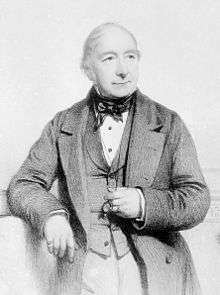Thomas Pettigrew


Thomas Joseph Pettigrew (28 October 1791 – 23 November 1865), sometimes known as "Mummy" Pettigrew, was a surgeon and antiquarian who became an expert on Ancient Egyptian mummies. He became well known in London social circles for his private parties in which he unrolled and autopsied mummies for the entertainment of his guests.[1]
Born in London in 1791, Thomas Pettigrew took medical studies, first as assistant to his father, who was a naval surgeon, and later as an apprentice at the Borough Hospitals. He had a distinguished medical career, becoming surgeon to the Duke of Kent and the Duke of Sussex. Pettigrew played an active role in intellectual Georgian and Victorian society, corresponding regularly with many well known surgeons, physicians, scientists, writers and artists, such as John Coakley Lettsom, Astley Cooper, Michael Faraday, George Cruikshank and Charles Dickens.[2]
... Pettigrew was appointed surgeon to the Charing Cross Hospital, upon its foundation, and lectured there upon anatomy, physiology, pathology, and the principles and practice of surgery. He resigned his post of senior surgeon in 1835, in consequence of a disagreement with the board of management, and for some years after his resignation he devoted himself to private practice, living in Savile Row. He was elected a fellow of the Royal Society in 1827, and in 1830 he took a leading part in the election of the Duke of Sussex to the office of president, on the retirement of Mr. Gilbert. He was a prominent freemason for many years before his death.[3]
From the 1830s on, Pettigrew increasingly focused on private practice and his antiquarian interests. He developed an interest in Egyptian mummies, and in 1834 published History of Egyptian Mummies, which has been described as "the historic cornerstone of the study in English" (Peck 1998). During this time he became well known in London social circles for his private parties, at which he displayed scientific curiosities, such as Egyptian mummies and Yagan's head. The Duke of Hamilton was so impressed with Pettigrew's work that he engaged Pettigrew to mummify him after his death. The Duke of Hamilton died in August 1852, and in accordance with his wishes his body was mummified by Pettigrew and interred in a sarcophagus on his estate.
When the British Archaeological Association was founded in 1843, Pettigrew became its founding treasurer. After his wife's death in 1854, he retired from medicine, and focused entirely on his antiquarian interests. He died in 1865 and is buried in Brompton Cemetery, London. Seven months after his death his library was sold at Sotheby's.[4] He married in 1811 and the marriage produced twelve children; three sons and three daughters survived him.[5]
Selected publications
- Memoirs of the life and writings of the late John Coakley Lettsom : with a selection from his correspondence ... in three volumes. London: Printed by Nichols, son, and Bentley, for Longman, Hurst, Rees, Orme, and Brown. 1817.
- Bibliotheca Susseriana. 1827.
- Observations on cholera; comprising a description of the epidemic cholera of India, London: S. Highley, 1831
- History of Egyptian mummies. 1834.
- On superstitions connected with the history and practice of medicine and surgery. London: J. Churchill. 1844.
- Memoirs of the life of Vice-Admiral Lord Viscount Nelson. London: T. & W. Boone. 1849.
- Chronicles of the tombs. London: H. G. Bohn. 1857.
- An inquiry into the particulars connected with the death of Amy Robsart (Lady Dudley), at Cumnor place, Berks, Sept 8, 1560. London: J. R. Smith. 1859.
- Medical portrait gallery. Biographical memoirs of the most celebrated physicians, surgeons, etc., etc., who have contributed to the advancement of medical science. London: Fisher, Son & Co. [1838-40]
- On the house of Gournay. London. 1863.
References
- ↑ Peck, William H. (1998). "Mummies of Ancient Egypt". In Aidan, Eve Cockburn; Reyman, Theodore A. Mummies, Disease and Ancient Culture. Cambridge University Press.
- ↑ Moshenska, Gabriel (2012). "Selected Correspondence from the Papers of Thomas Pettigrew (1791–1865), Surgeon and Antiquary". Journal of Open Archaeology Data. 1 (2). doi:10.5334/4f913ca0cbb89.
- ↑

- ↑ "Guide to the Pettigrew Papers OSB MSS 113". Yale University Library.
- ↑ "Pettigrew, Thomas Joseph". Plarr's Lives of the Fellows Online, Royal College of Surgeons.
External links
| Wikimedia Commons has media related to Thomas Pettigrew. |
- Archive.org Full Text of History of Egyptian Mummies